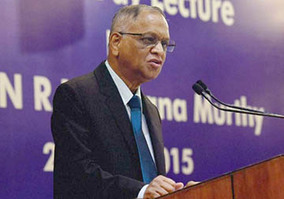
BANGALURU - India and the US should collaborate in higher education, research and hi-tech areas to benefit mutually and foster a stronger bond of friendship between the two countries, Infosys co-founder N.R. Narayana Murthy said on Friday. "Greater collaboration between the two countries in these areas, especially in research at university level and hi-technology will lay a strong foundation for our country's growth...

in the long term," Murthy said in a keynote address at the Indo-American Chamber of Commerce (IACC) conclave on "Vision 2020" here.
Noting that the US was the undisputed number one in higher education and research, he said that to make the Prime Minister Narendra Modi's 'Make in India' dream a success, scientists and engineers would have to first discover and innovate. "If we want to find solutions to problems in education, healthcare, agriculture, nutrition and in shelter, our scientists and engineers will have to discover and invent before making in India," Murthy said, citing recent remarks of Nobel laureate and string theorist David Gross on Indian science and technology.
He called for partnerships with consortia of reputed US universities in each area, and exchange of faculty and students between Indian and American universities by hundredfold. "We will have to issue 10-year multiple entry visas every year to hundreds of thousands of US academicians. Every conference in India, certified to be an A grade conference, will have to be given travel and stay grant for at least 50 academicians from the US. The government must provide 50 travel-and-stay grants for Indian academicians to attend every such conference in the US," Murthy urged.
As most Indian students going to the US for higher studies stay back by taking jobs in the industry or academia, he said the government would have to sign an agreement with the US not to employ Indian students finishing research so that they could return to serve the country for at least 10 years. "Leaders of both countries have also to agree to send about 10,000 students (1,000 students in 10 areas of STEM or Science, Technology, Engineering and Math) every year to do PhD in important areas in the US for the next 50 years. This will cost us $5 billion a year, which is less than 0.25 percent of our GDP. It is a small sum but will yield enormous benefits to us in the long term," he noted. Murthy said such tie-ups between the two nations would help in developing solutions in the emerging area of Internet of Things (IoT), as they have tremendous future.
"India has to become a partner in adding value to US firms by developing advanced software in IoT to them and their customers. This requires us to train our youngsters in multi-tasking kernels, device drivers, and adaptive control and in handling analog-digital, digital-analog, digital input and digital output devices," he added.
Noting that the US was the undisputed number one in higher education and research, he said that to make the Prime Minister Narendra Modi's 'Make in India' dream a success, scientists and engineers would have to first discover and innovate. "If we want to find solutions to problems in education, healthcare, agriculture, nutrition and in shelter, our scientists and engineers will have to discover and invent before making in India," Murthy said, citing recent remarks of Nobel laureate and string theorist David Gross on Indian science and technology.
He called for partnerships with consortia of reputed US universities in each area, and exchange of faculty and students between Indian and American universities by hundredfold. "We will have to issue 10-year multiple entry visas every year to hundreds of thousands of US academicians. Every conference in India, certified to be an A grade conference, will have to be given travel and stay grant for at least 50 academicians from the US. The government must provide 50 travel-and-stay grants for Indian academicians to attend every such conference in the US," Murthy urged.
As most Indian students going to the US for higher studies stay back by taking jobs in the industry or academia, he said the government would have to sign an agreement with the US not to employ Indian students finishing research so that they could return to serve the country for at least 10 years. "Leaders of both countries have also to agree to send about 10,000 students (1,000 students in 10 areas of STEM or Science, Technology, Engineering and Math) every year to do PhD in important areas in the US for the next 50 years. This will cost us $5 billion a year, which is less than 0.25 percent of our GDP. It is a small sum but will yield enormous benefits to us in the long term," he noted. Murthy said such tie-ups between the two nations would help in developing solutions in the emerging area of Internet of Things (IoT), as they have tremendous future.
"India has to become a partner in adding value to US firms by developing advanced software in IoT to them and their customers. This requires us to train our youngsters in multi-tasking kernels, device drivers, and adaptive control and in handling analog-digital, digital-analog, digital input and digital output devices," he added.

 RSS Feed
RSS Feed
